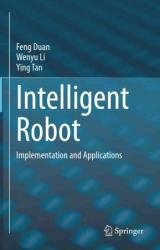Intelligent Robot: Implementation and Applications
- Добавил: literator
- Дата: 23-02-2023, 10:58
- Комментариев: 0
 Название: Intelligent Robot: Implementation and Applications
Название: Intelligent Robot: Implementation and ApplicationsАвтор: Feng Duan, Wenyu Li, Ying Tan
Издательство: Springer
Год: 2023
Страниц: 293
Язык: английский
Формат: pdf (true), epub
Размер: 26.3 MB
Today, the development of robots is making steady advances. In particular, the Robot Operating System (ROS) offers a unified platform that greatly facilitates the development of robots and has become a new hotspot for learning and application in the field of robotics research.
This book introduces readers to the key technologies and development methods for ROS-based intelligent robots. Covering both the development history of robots and various aspects of programming robots, it offers effective support for beginners.The book is divided into three parts, the first of which introduces the basics of robots, including their definition, development, composition, and key technologies. In turn, the second part covers the hardware and software components and the implementation of functions such as vision, speech, grasping, and autonomous navigation. These functions need to work together to provide user-friendlier and more intelligent service. The third part shows how to develop robots with different functions in different application scenarios.Combining theoretical and practical aspects, with a strong focus on application, this work can be used as a reference book for robotics-related courses. Moreover, it will benefit all readers who are interested in intelligent robot development, sharing essential insights into developing service robots based on ROS.
After the correct installation of ROS, we will continue to learn the ROS framework with the initial usage. In the ROS framework section, we will help readers to understand the composition and resource distribution of ROS fully. The ROS framework consists of three levels: file system level, computational graph level, and community level; after understanding the basic framework of ROS, we will introduce the basics of ROS usage, mainly including the introduction of catkin, workspaces and their creation, creation and compilation of project packages, creation and compilation of ROS nodes and running them, the use of roslaunch, the creation of ROS messages and services, how to write test message publishers and subscribers in C++ or Python, how to write test Servers and Clients in C++ or Python, and more. The content of this chapter is the basis for conducting subsequent chapters, and you should be proficient in it.
We have gained a preliminary understanding of the basic framework of the ROS robot operating system, and the best way to further understand the mechanics of how the ROS system works is to test it on a physical robot. Currently, most robot platforms on the market are relatively expensive and have uneven scalability, which is not conducive to use by groups such as robotics enthusiasts and students. Turtlebot is an inexpensive, scalable, and extremely ROS-friendly robot platform, and Turtlebot2 was chosen as the test platform for this book. Turtlebot2 is an official ROS-built robotics platform that runs on the Kobuki base, which is well supported by all versions of ROS, and the routines in this book run primarily on the Turtlebot2 robotics entity.
The main topics in this chapter include: the hardware composition and configuration of the Turtlebot2 robot, software installation and testing; how to start the Turtlebot2 robot, how to control the Turtlebot2 robot movement through keyboard manual control and scripting, and how to monitor the Kobuki base battery status; and finally, the extensions of the Turtlebot2 robot , i.e., the hardware architecture and software framework on which the implementation of the various functions of the robot in this book depends. This chapter gives the reader an initial understanding of the Turtlebot2 robot and the ability to manipulate it in a simple way; at the same time, it builds an overall understanding of the hardware structures and software frameworks on which the implementation of the various robot functions covered in subsequent chapters of this book depends.
Contents:
Скачать Intelligent Robot: Implementation and Applications
Внимание
Уважаемый посетитель, Вы зашли на сайт как незарегистрированный пользователь.
Мы рекомендуем Вам зарегистрироваться либо войти на сайт под своим именем.
Уважаемый посетитель, Вы зашли на сайт как незарегистрированный пользователь.
Мы рекомендуем Вам зарегистрироваться либо войти на сайт под своим именем.
Информация
Посетители, находящиеся в группе Гости, не могут оставлять комментарии к данной публикации.
Посетители, находящиеся в группе Гости, не могут оставлять комментарии к данной публикации.

